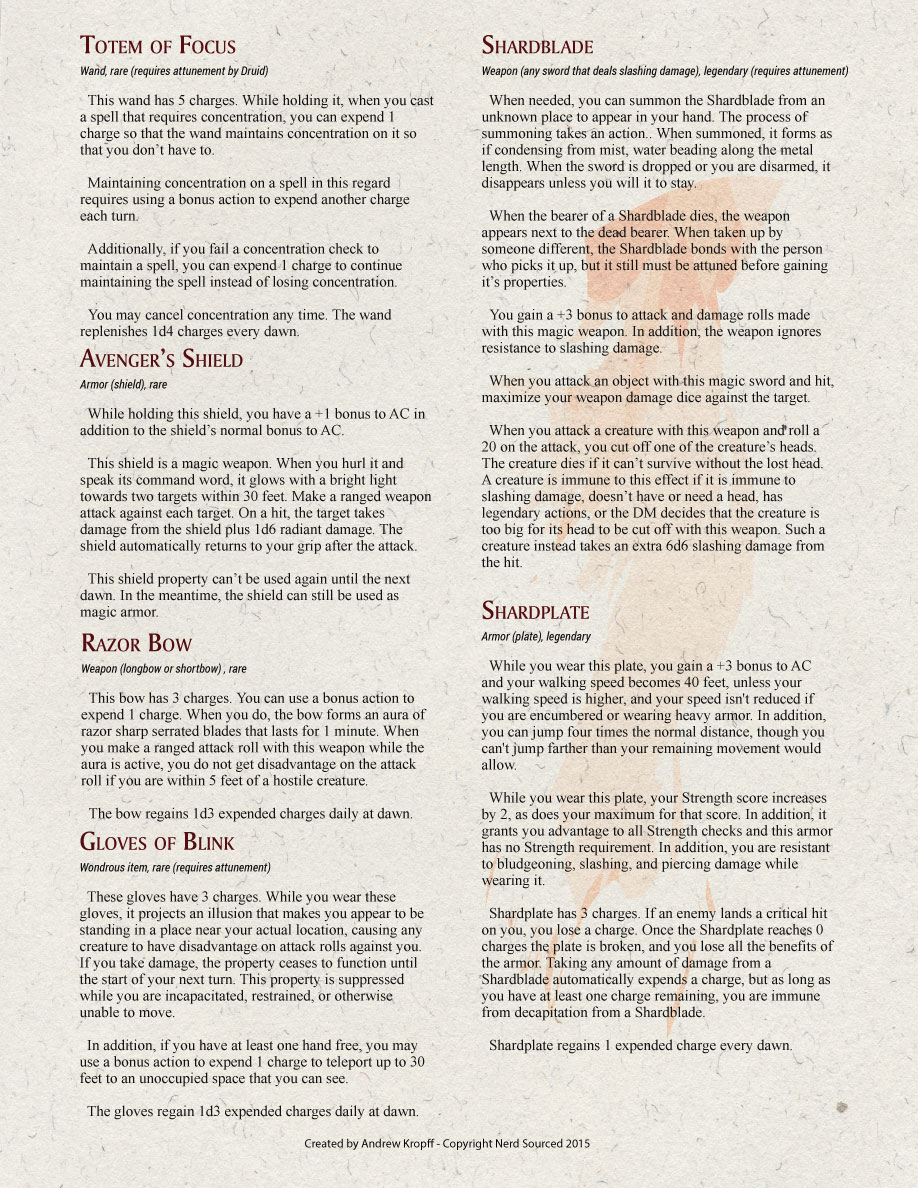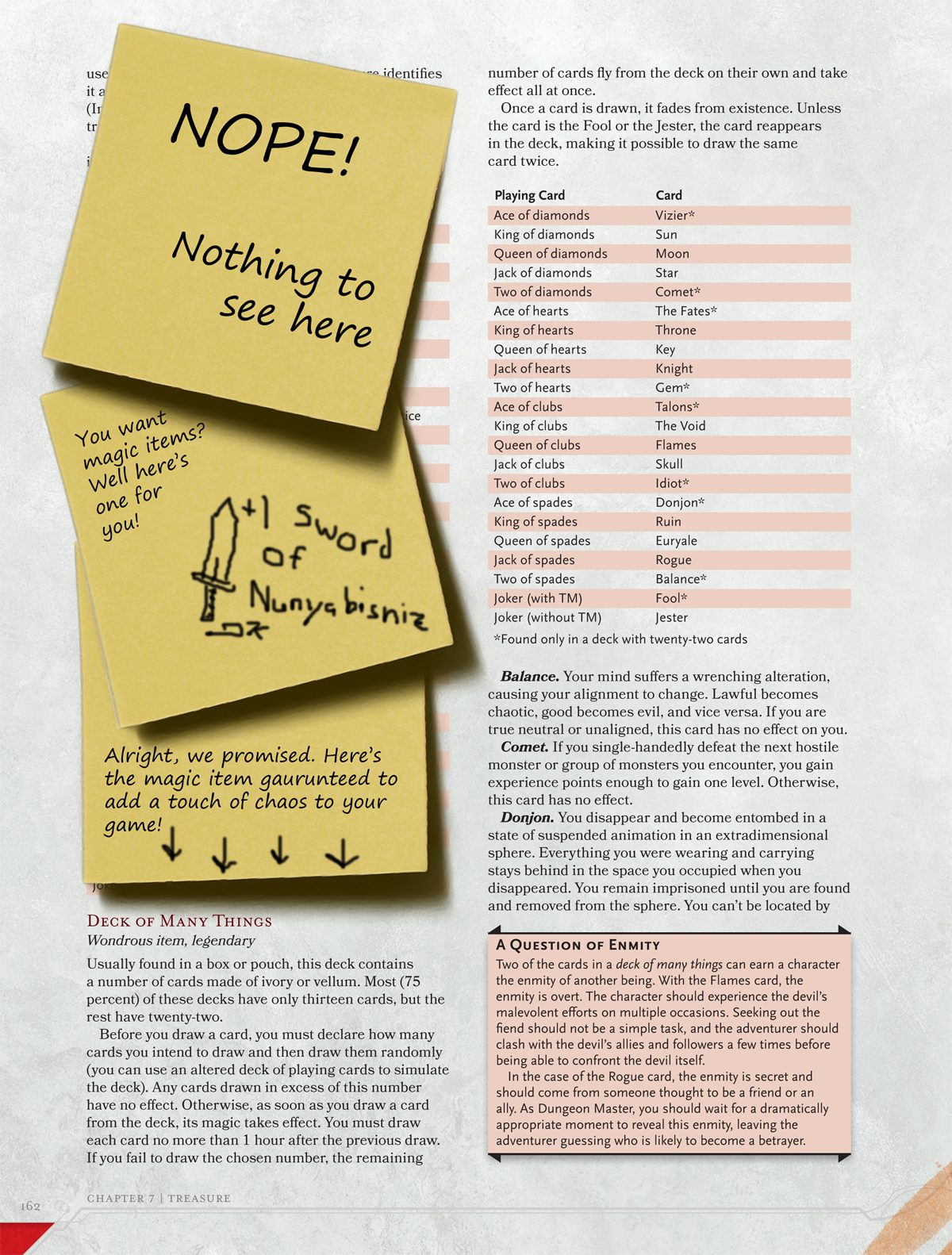
Enticing Offer: Knowledge of players’ creation of the item has spread across the city. Players can role play how this emotion emerges. Emotional Requirements: The formula for a rare item requires raw emotion to be harnessed during the creation of an item. Players must find these sources (book, person, history knowledge) in order to create the item.  Cryptic Cross-Reference: A shoddy formula references outside sources. This can result in a perk, quirk, or flaw in the item. Doing an Arcana check, a player can decide which option is best. Contradictory/Incomplete Instructions: The formula is either incomplete or notes that two sources disagree on a step in the process.
Cryptic Cross-Reference: A shoddy formula references outside sources. This can result in a perk, quirk, or flaw in the item. Doing an Arcana check, a player can decide which option is best. Contradictory/Incomplete Instructions: The formula is either incomplete or notes that two sources disagree on a step in the process. #Dmg 5e magic items table how to
Using wit, players can decide how to fix or work around the construction challenge.
Construction Challenge: One or more elements of an item’s design are particularly difficult to execute. Taking inspiration from Pathfinder, here is a list of challenges a DM could throw at players. If a party is interested in roleplaying their item creation, a DM may decide to throw in some additional challenges players must overcome. Dangerous Mining: In the ridge of an active volcano, players must mine precious ore under the pressure of a ticking molten clock. Or maybe they need to ask a Deva for a feather from his wing.  Gather Non-Lethal Creature Components: Players can sneak past a giant troll to find a toenail of his that he peeled off.
Gather Non-Lethal Creature Components: Players can sneak past a giant troll to find a toenail of his that he peeled off.  Nature Skills: Players must use herbalist skills to harvest components without destroying the plant. Trading: Trade for an item by fulfilling requests or bribing. A Prince’s Grace: Players must discover a way to acquire an item of a high-ranking prince or nobility (in large or small quantities). Illegal Ingredients: One or more of the required ingredients must be obtained through criminal means (smuggling, stealing, black market, etc). Here are some non-creature encounters with potentially high CRs: Players need not always defeat a monster to gain components. In addition to the DMG and UA rules above, here are some additional guidelines a DM may consider. Keep in mind that you may need to either have skills and proficiencies or find someone who does have these skills to help complete the item. When you think you have a few components that could be used to craft a specific magic item based on the item description and function, tally up the CR and time spent, then talk to your Dungeon Master and see what would be required to finish the magic item based on the tables above and additional DM-provided guidelines. Also, estimate how much in-game time you have spent gathering each component. To estimate a CR for social encounters, see our guide here. Keep inventory of what component you’ve gathered and ask your Dungeon Master to estimate what CR can be associated with the component, whether from slaying a creature or completing a social encounter like shopping, bartering, or stealing. To do this, a player will need to be familiar with magic item crafting requirements and readily communicate their plans with their Dungeon Master. This should be outlined in the formula.īecause there are no canonical book-derived formulas, players have a chance to compose their own formulas based on components they have harvested throughout their adventuring. Example: Flame tongue requires forging with lava. A Dungeon Master can decide if a character needs particular tools or supplies, or if an item can only be created at a certain location. Depending on the item’s rarity, a character must meet a minimum level to craft that item. Magical items that do not produce spells still require spellcasters to create the item (such as a +1 weapon). This includes having and expending material components the spell requires. A character must have the spell slots and be able to cast a spell that an item will produce in order to imbue an item with that magic. This can be something characters have developed in-game (with the DM’s approval) or an established formula from a reputable (or not) source.
Nature Skills: Players must use herbalist skills to harvest components without destroying the plant. Trading: Trade for an item by fulfilling requests or bribing. A Prince’s Grace: Players must discover a way to acquire an item of a high-ranking prince or nobility (in large or small quantities). Illegal Ingredients: One or more of the required ingredients must be obtained through criminal means (smuggling, stealing, black market, etc). Here are some non-creature encounters with potentially high CRs: Players need not always defeat a monster to gain components. In addition to the DMG and UA rules above, here are some additional guidelines a DM may consider. Keep in mind that you may need to either have skills and proficiencies or find someone who does have these skills to help complete the item. When you think you have a few components that could be used to craft a specific magic item based on the item description and function, tally up the CR and time spent, then talk to your Dungeon Master and see what would be required to finish the magic item based on the tables above and additional DM-provided guidelines. Also, estimate how much in-game time you have spent gathering each component. To estimate a CR for social encounters, see our guide here. Keep inventory of what component you’ve gathered and ask your Dungeon Master to estimate what CR can be associated with the component, whether from slaying a creature or completing a social encounter like shopping, bartering, or stealing. To do this, a player will need to be familiar with magic item crafting requirements and readily communicate their plans with their Dungeon Master. This should be outlined in the formula.īecause there are no canonical book-derived formulas, players have a chance to compose their own formulas based on components they have harvested throughout their adventuring. Example: Flame tongue requires forging with lava. A Dungeon Master can decide if a character needs particular tools or supplies, or if an item can only be created at a certain location. Depending on the item’s rarity, a character must meet a minimum level to craft that item. Magical items that do not produce spells still require spellcasters to create the item (such as a +1 weapon). This includes having and expending material components the spell requires. A character must have the spell slots and be able to cast a spell that an item will produce in order to imbue an item with that magic. This can be something characters have developed in-game (with the DM’s approval) or an established formula from a reputable (or not) source. 
Characters need a formula that describes the construction of the item.












